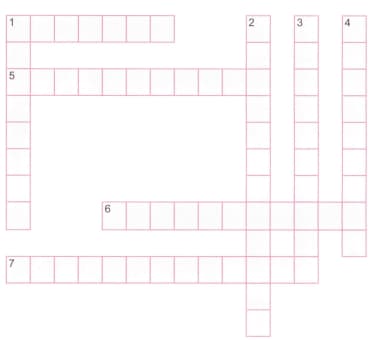Solve the crossword puzzle with the help of the clues given below.

Across
1. Method used to separate components of a mixture which differ in size (7)
5. Process of pouring out the liquid without disturbing the sediment (11)
6. Process of converting liquid into vapour (11)
7. Process of settling down of heavier particles (13)
Down
1. Formation of a layer of solid particles during sedimentation (8)
2. Conversion of water vapour into liquid form (12)
3. Separation of an insoluble solid from a liquid using a filter (10)
4. Process of separating lighter components from the heavier ones by wind (9)

1. Method used to separate components of a mixture which differ in size (7)
5. Process of pouring out the liquid without disturbing the sediment (11)
6. Process of converting liquid into vapour (11)
7. Process of settling down of heavier particles (13)
1. Formation of a layer of solid particles during sedimentation (8)
2. Conversion of water vapour into liquid form (12)
3. Separation of an insoluble solid from a liquid using a filter (10)
4. Process of separating lighter components from the heavier ones by wind (9)

Important Points to Remember in Chapter -1 - Separation of Substances-Cleaning of Food from Neha Sharma Start Up Science 6 Solutions
(i) Substances which contain only one type of constituent particle either of an element or a compound are known as pure substances. For example, copper, iron, water, common salt and sugar.
(ii) Substances that contain two or more than two types of elements or compounds in no fixed ratio are called impure substances. For example, Air (the constituents of air are oxygen, nitrogen, carbon dioxide, dust, water vapour).
(iii) A mixture is a material made by mixing two or more substances which can be easily separated.
(iv) The constituents of a mixture do not lose their original properties such as particle’s size, density, melting point, boiling point, etc.
2. Solution :
(i) Solute is a substance that dissolves in another substance, e.g. salt, sugar.
(ii) Solvent is a substance in which solute dissolves, e.g. water.
(iii) A mixture of solute and solvent is called solution.
(iv) A solution in which more of a substance can be dissolved is called an unsaturated solution.
(v) A saturated solution is one in which no more of a substance can be dissolved at a fixed temperature.
(vi) The quantity of a substance that can be dissolved in a fixed amount of another substance at a given temperature is fixed and is called the solubility of the substance.
3. Methods of separation :
(i) Handpicking is the simplest of all methods. Ex: Small pebbles are picked up from rice or wheat.
(ii) Winnowing is used by farmers for separating lighter husk particles from heavier grains of wheat.
(iii) The process used to separate grains from stalks is called threshing.
(iv) A sieve has a fine net or gauze fixed on a wooden or metal frame. It is used for separating fine particles from the bigger ones. This process is known as sieving.
(v) When the heavier component of a mixture settles down in the container, it is called sedimentation.
(vi) The process of increasing the rate of sedimentation in a suspension, by adding chemicals, such as alum is called Loading.
(vii) Decantation is the process of pouring the upper clear liquid into another container without disturbing the sediments.
(viii) Decantation is used for purifying river water containing sand. This is also used for the separation of mud or sludge from sewage (waste water of cities).
(ix) Separating funnel is a funnel provided with a tap, used for separating two immiscible liquids.
(x) In filtration the mixture is dropped on a porous material known as filter. The liquid passes through the filter and comes down as filtrate. The insoluble solid left behind is known as residue.
(xi) The principle of centrifugal force is applied for separation of solids and liquids. This method is called centrifugation.
(xii) The process of conversion of water into vapour form is called evaporation.
(xiii) The process of conversion of vapour of a liquid to its liquid form is called condensation.
(xiv) The process of removing impurities and obtaining a pure substance is called purification or refining.
(xv) A substance is a type of matter that cannot be separated into other types of matter by physical method.
(xvi) The process of separating the components of a liquid by agitating it vigorously is known as churning.
